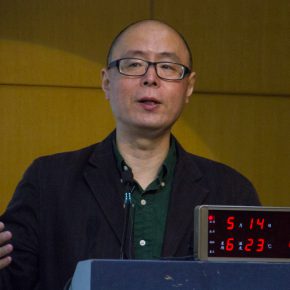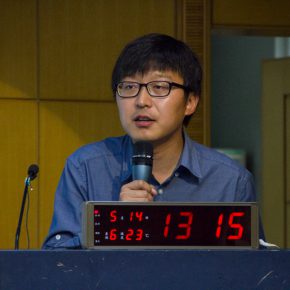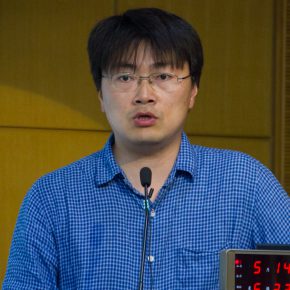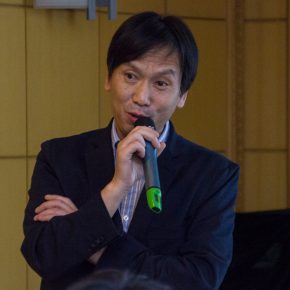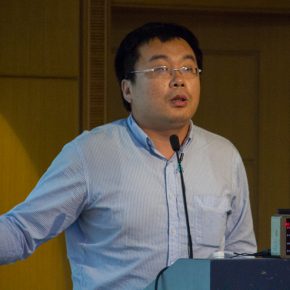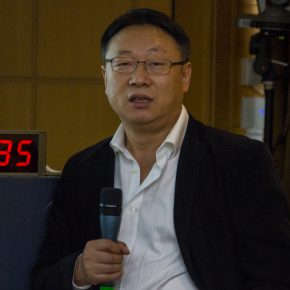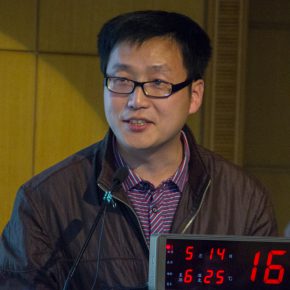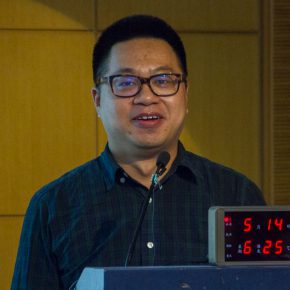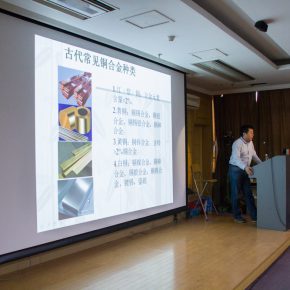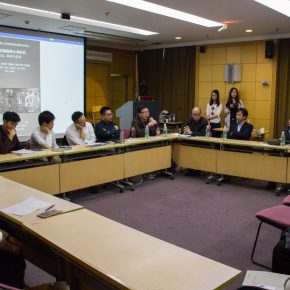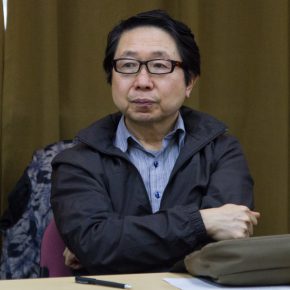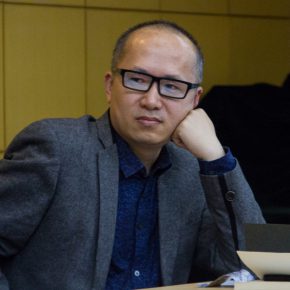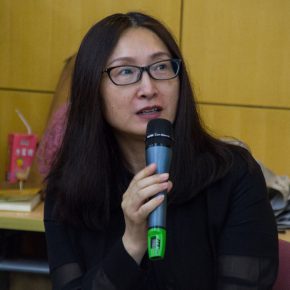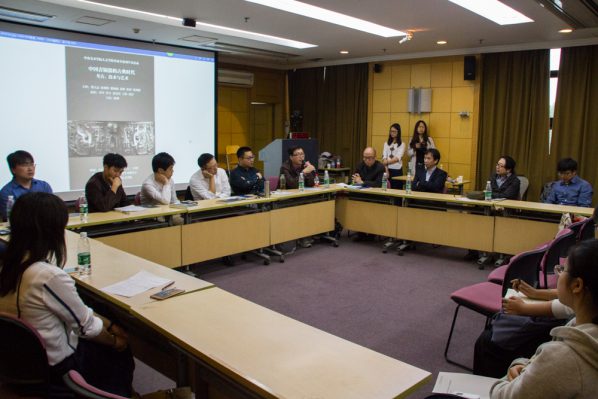
On the afternoon of May 14, 2016, the academic salon “Classical Age of Chinese Bronze - Archeology, Technology and Art” was held in the academic lecture hall at CAFA Library, this salon is one of the academic events held by the School of Humanities during the CAFA Graduation Season, the scholars engaged in the bronze research are from a variety of institutions, the teachers and students from CAFA gathered to share an academic feast.
The salon was presided over by Postdoctoral Geng Shuo from CAFA. First of all, Deputy Dean of the School of Humanities, CAFA Prof. Li Jun put forward three questions: Firstly, what is the relationship between China and bronzewares? The Chinese characters of “Zhongguo (China)” first appeared in the inscriptions of the bronze wares “He Zun”, as a classical art style, the bronze art also made a historical footnote for the grand age; secondly, from wares to the way, where is the way? It refers to how to, through the study of bronze wares, pursue the secrets of Chinese civilization. Archeology, technology and art constitute one way. Thirdly, why is it held in CAFA?
After a wonderful opening remark given by Prof. Li Jun, the salon formally started discussions. The event is divided into three parts including “Archeology”, “Technology” and “Art”, each group is composed of the reports by the two scholars, together with a guest commentator. After the end of the reports it entered into discussion session and the Dean of the School of Humanities Prof. Yin Jinan finally made a concluding remark.
“Archaeology”: Cao Dazhi from the School of Archaeology and Museology at Peking University & Zhang Wenjie from the School of History at Xiamen UniversityThe first group is “Archeology” which invited the two lecturers Assistant Professor Cao Dazhi from the School of Archaeology and Museology at Peking University and Assistant Professor Zhang Wenjie from the School of History at Xiamen University, the commentator is a researcher of Gansu Institute of Archaeology Wang Hui.
Cao Dazhi’s report is entitled “Provenance Analyses of Several Bronze Wares of the Shang Dynasty Unearthed in Loess Hills” which is divided into two parts, firstly the significance of studying the provenance of bronze wares, and secondly the method of provenance research. Cao Dazhi pointed out that the production of a large number of bronze wares was an important criterion to measure whether it was a developed area or not, because the casting of bronze wares demanded a large support from political, economic and cultural resources. So that, the provenance study of bronze wares was of great significance. For research methods, Cao Dazhi had summarized three types including typology, style analysis and scientific analysis, and he believed that it should synthetically use a variety of methods rather than singly using a particular method. Thereafter, Cao Dazhi used the provenance analyses of several bronze wares of the Shang Dynasty unearthed in Loess Hills to demonstrate the above views.
Zhang Wenjie had a long-term research on the sacrificial wares of bronze, he published the monograph “Study of the Chu State’s System of Bronze Sacrificial Wares”, focused on which the report was entitled the “Display of Funeral Bells and the Suspension System of Bells and Chime Stones of the Zhou Dynasty”. The three topics include: How did the suspension system of bells and chime stones of the Zhou Dynasty become furnished? What are the similarities and differences of the flex bells and chime stones between the narrative texts of ancient books and records and the archaeological data? Is the display of funeral bells consistent with the ancestral temple rituals and music? Correspond to the three issues, this report finally made three conclusions, firstly, the number of bells and chime stones of various surfaces are similar in the suspension system, and bells and chime stones are located in the same surface when they are played, there might be differences in the functions and names between the bells and chime stones which are located on various surfaces (the ancestral temple suspension system of rituals and music); secondly, the folding bells and chime stones of the tombs are only a formalized suspension system of rituals and music, which can’t be considered as a basis for restoring a suspension system of rituals and music (system of funeral bells); thirdly, funeral events of Zhou Dynasty and the choices of sacrifices, which has its own guidelines and testimonies, which is closely linked to the system of ancestral temples but they are not exactly the same, the funeral system does not cover the full view of theritual system.
Commentator Wang Hui said he was inspired by the two reports.
“Technology”: Cui Jianfeng & Li Haichao from the School of Archaeology and Museology at Peking UniversityIn the second group of “Technology”, Associate Professor Cui Jianfeng & doctoral candidate Li Haichao from the School of Archaeology and Museology at Peking University respectively gave a speech. Researcher of the Institute for the History of Natural Sciences, Chinese Academy of Sciences Su Rongyu served as the commentator.
Cui Jianfeng has an educational background in science and engineering, and currently he is mainly engaged in the study of technological archaeology, and the report is entitled “Exploration of the Development History of Chinese Early Bronze Technology”. First of all, Cui Jianfeng gave a detail introduction of the chemical element Cu and species of ancient common copper alloys. He believed that ancient Chinese people chose tin bronzes because they have of golden metallic lustre and good mechanical properties. He had a summary of the technological analyzing results of the bronze wares discovered in China of the late Longshan Period (before 1900 BC), and the samples included were detected and published data of 52 pieces of bronze wares from the Erlitou site, as well as the data of a piece of slag and a lead sheet, which is particularly concerned about the lead content. Referring to Central Plains region, the late Neolithic Chinese bronze casting technology circle is divided into four circles: Gansu and Qinghai technological circle in the Western China; Northern China technological circle; Eastern China technological circle; Southern China technological circle. Through the comparison between the four technological circles, he proposed the Central Plains Arsenic Copper Era. The conclusion is that the copper smelting technology in the Northwest China was likely to have been introduced from the West; on the other hand, Northern, Central, Northernand Southern bronze technologies had a feature of localization, although the cause is not yet clear, the impact on the bronze technology of the Central Plains is obvious.
Li Haichao gave a speech entitled “Exploration of the Bonze Production and Distribution System of the West Zhou Dynasty – Taking the Bronze Wares Unearthed from Ye Jiashan Cemetery”. Li Haichao gave classified research on the bronze wares unearthed at Ye Jiashan Cemetery (according to the inscriptions and quality), group study of traces elements, the study of lead isotope, and reference to the materials of other vassal states, finally he concluded that: the high quality bronze and original porcelain treasure resourceswere likely to be uniformly produced and distributed by the central government in the early West Zhou Dynasty, but many vassal states conducted a few small-scale bronze casting activities.
Su Rongyu made wonderful comments on the reports and praised the rigorousness of the two young scholars.
“Art”: Su Hui & Zhang Chong from Institute of History at Chinese Academy of Social SciencesThe third part is art. Deputy Editor of the CASS Institute of History Su Hui firstly made a report entitled “Inside Equals Outside: Orientations of the Bronze Ornamentation Research of the Western Zhou Dynasty”. It is divided into three parts, namely researching the bronze ornamentation of the Shang and Zhou Dynasties; summary of the perspectives of bronze ornamentation research of the Shang and Zhou Dynasties; unifying of ornamentations and utensils research.
The last speaker was the assistant researcher of the Institute of History at the Chinese Academy of Social Sciences and the doctoral candidate of the School of Humanities, CAFA Zhang Chong, who gave a speech entitled “Style and Ethnicity: Taking Gongyu State in Baoji and Daijiawan Bronze as Examples”. Zhang Chong analyzed the bronze wares of the Gongyu State in Baoji and Daijiawan from the style and ethnicity, the hidden and prominent beasts’ faces, geographical space and the art gathering place, to make a preliminary conclusion: Gongyu State’s culture is a culture interposed between the Shang and Zhou culture, and it was flourishing with the influence of Shang’s civilization and even Southwestern civilization, while it also inspired Zhou’s culture.
Discussion: All Scholars Together Discussed the “Classical Age of Chinese Bronze”This part of the discussion was moderated by Su Rongyu. In this part, together with the 6 young scholars, Su Rongyu, Li Jun, Du Juan, Wang Yun had a lively and wealthy discussion on the issues including the basis to bring together Shigu Mountain and Gongyu State in Baoji in a discussion, the differences between birds’ patterns and dragons’ patterns, etc.
Dean of School of Humanities, CAFA Yin Jinan finally made a concluding remark. Yin Jinan said that, the academic salon on bronze started discussions from a multi-method and interdisciplinary perspective which was a good way.
Text by Chen Yulian, Photo by Hu Sichen/CAFA ART INFO
Translated by Chen Peihua and edited by Sue/CAFA ART INFO



